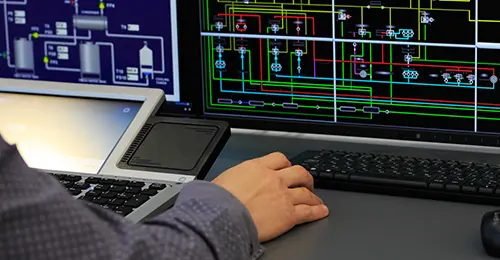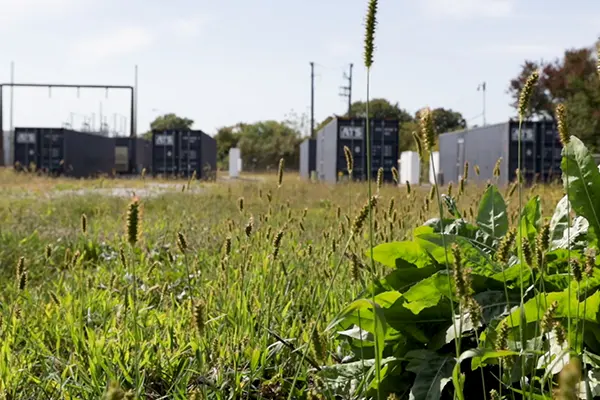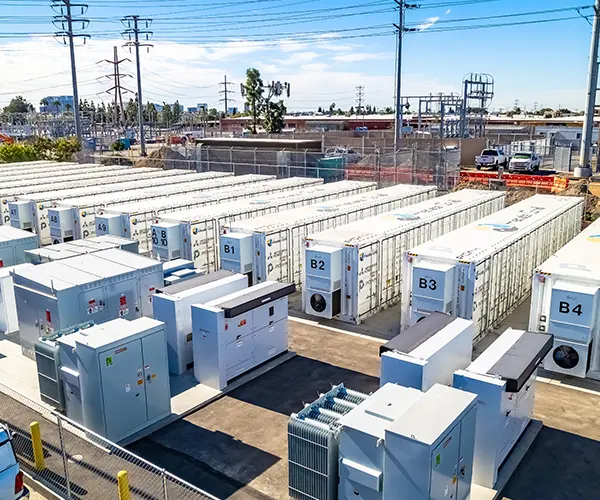Energy Storage

What is Energy Storage?
Powering our daily lives, energy storage saves electricity until it is later needed. Common forms of energy storage can be found in household items, including the lithium-ion batteries in our cell phones and laptops.
Hecate Grid uses similar lithium-ion battery cells, but on a much larger scale, to build safe and effective Battery Energy Storage Systems (BESS). These systems help to prevent blackouts, improve power grid efficiency, and provide a reliable and flexible supply of energy at times when some forms of power generation may not be available – such as at night when the sun’s rays cannot fuel solar facilities.
To learn more about energy storage technologies, visit cleanpower.org.
Battery Storage Lowers Energy Costs
By boosting grid efficiency, sustainability, and resilience, energy storage plays a pivotal role in lowering energy costs while fortifying our energy systems.


Supporting Renewables: Battery storage enables increased deployment of renewables, accelerating the use of the most cost-effective power generation sources.
Minimizing Energy Waste: By storing surplus renewable energy during periods of excess supply, energy storage ensures the optimal use of clean energy when demand is higher.
Enhancing Grid Efficiency: With instant dispatchability, energy storage serves as both a power source and a power consumer, adapting to demand fluctuations and optimizing grid efficiency. This improved operational flexibility reduces transmission congestion, enhances overall grid performance, and curtails system costs.
Boosting Energy Security: Energy storage reduces reliance on costly energy imports, contributing to a more secure and affordable energy landscape.
Ensuring Reliability and Preventing Outages: Energy storage acts as a reliable backup during peak demand, safeguarding against power outages and disruptions to ensure the safety and stability of communities.
Enabling a Cleaner Grid
The U.S. Department of Energy’s National Renewable Energy Laboratory (NREL) has found that large quantities of energy storage could successfully support an electric grid run entirely on renewables.
1,200
Gigawatt-hours of energy storage that the NREL predicts may be needed by 2050 to meet decarbonization targets. This massive goal will require significant investment in the deployment of battery energy storage systems across North America.
111
Gigawatt-hours of energy storage that the U.S. Energy Information Administration expects to be deployed within the U.S. by the end of 2025. This means that by 2025, we will only have installed 9.5 % of the total battery capacity needed to run our grid entirely on clean energy.
How Do Battery Energy Storage Systems (BESS) Work?
Battery Energy Storage Systems (BESS) operate similarly to the rechargeable battery used in your cell phone.
Charge:
Just like charging a cell phone, the BESS takes electricity from the grid and stores it for later use.
When? This charging typically occurs when electrical energy is plentiful – such as sunny days when solar projects produce abundant solar power.
Discharge:
The batteries discharge the stored electricity back onto the grid during high-demand periods or when renewable sources are not producing enough power.
When? Energy is often needed in the evening, as the sun goes down and solar generation fades.
By timing these charge and discharge cycles with the needs of the grid, a BESS can help ensure a sustained and reliable electricity supply.


Safety
Hecate Grid puts safety of people and property first in everything we do.
Safety considerations are fundamental to the design and proper operation of all parts of our electric grid, including energy storage systems.
By following best practices, performing proper maintenance, and adhering to rigorous national safety standards, energy storage systems sustain a safety record consistent with the other technologies we rely on for our daily electricity needs.
What We Do to Ensure Safety
Hecate Grid incorporates the following industry-standard precautions to minimize operational risk:
Equipment Certification
Hecate Grid uses battery equipment that is UL 9540A certified, a rigorous universal standard designed to meet or exceed local, state, national, and international building and fire codes.
Pre-Operation Testing
Before operation, all new utility-scale battery systems pass standard safety tests to ensure they conform with the highest global safety standards.
Temperature Management
Our energy storage projects use ventilation and heating or cooling equipment to keep all batteries within safe operating temperatures.
Safety Equipment
All projects have critical safety systems installed to detect thermal events, suppress fires, and vent gases safely.
Situational Awareness
A battery management system is utilized at each project to continuously monitor, control, and optimize performance of the facility. It can disconnect individual or multiple battery modules if it detects abnormal temperature conditions.
Real-Time Monitoring
Our facilities are monitored around the clock by energy professionals who are trained in properly identifying and responding to thermal events.
Fire Breaks
Hecate Grid projects are surrounded by wide gravel breaks and masonry walls where appropriate.
Emergency Preparedness
Hecate Grid engages local first responders in preparatory emergency operations planning, including hosting specialized firefighter training classes, and contributes funding to local fire departments.
Frequently Asked Questions

While any fire – including those at energy facilities – may pose risks to first responders, we significantly reduce these risks through close collaboration with local fire departments to develop tailored emergency response plans using a national template of best practices. Covering various scenarios like weather extremes, fires, and security issues, these plans emphasize coordination and the sharing of expert information to guide proper safety actions and keep firefighters safe.
Battery storage projects are built to exacting standards designed to keep people and surrounding communities safe, even in the rare instance that things go wrong. A 2023 report released by New York State’s Inter-Agency Fire Safety Working Group, using the latest information available about battery fires, found no evidence of harmful levels of toxic contaminants spreading beyond site boundaries because of a fire.
Battery storage systems do not release pollutants during normal operation.
Battery energy storage systems must adhere to state and local electrical and fire codes. Owners submit system certification, fire safety tests, and emergency response plans with all relevant jurisdictional authorities for approval.
Battery energy storage facilities are designed to endure severe weather, while also enhancing grid resilience against weather conditions, averting blackouts, and delivering backup power.